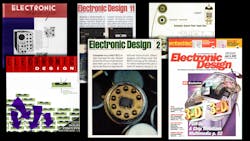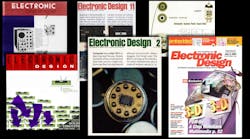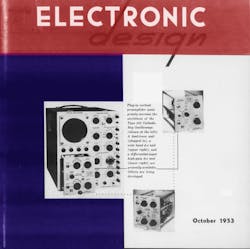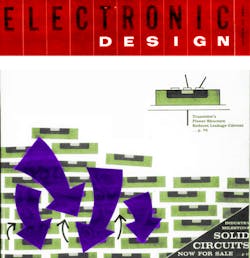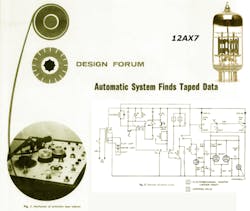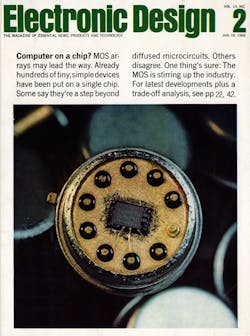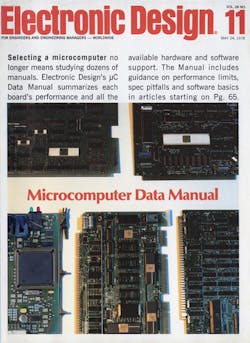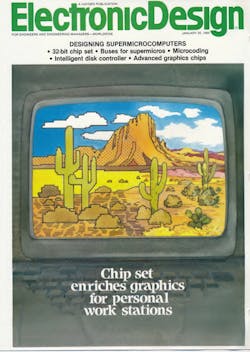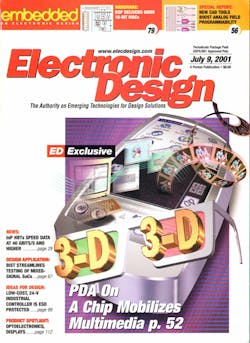Electronic Design: Now and Then
What you’ll learn:
- The history of Electronic Design
- Landmark innovations covered in Electronic Design over the past seven decades.
The Electronic Design Now and Then series highlights electronic technologies covered by us in the past and what technologies might have replaced them.
Electronic Design magazine has been around longer than me and I’ve been around a long time. My father was an electrical engineer, too, and would have read the first issues of our publication. I wish I had a copy of the first issue to show, but instead I will have to go with Issue 10 from 1953 (Fig. 1). Hopefully I’ll be able to provide access to these older issues in the future.
At that time, vacuum tubes, cathode ray tubes, and transistors were coexisting. One of the articles in Issue 10 was “Gating and Switching Circuits Employing Transistors” (Fig. 2). It was written by R.L. Trent, who worked for Bell Telephone Laboratories in Murray Hill, N.J. The labs are still around but are now known as Nokia Bell Labs. It’s credited with the development of numerous technologies from the transistor to the C programming language. The article talked about the use of transistors for logic functions as well as a monostable multivibrator for pulse generation.
The Ideas for Design section was part of the magazine back then, but it didn’t formally get the name until later. These were short articles by engineers on projects they wanted to share; they often used hardware and software in different ways than originally intended.
Transistors were more popular as time moved on. Still, even in the 1960s, vacuum tubes continued to play a critical role (Figs. 3 and 4). The article from Volume 8 Issue 7 titled “Automatic System Finds Taped Data” uses a dual-triode 12AX7 vacuum tube with a high voltage gain along with relays and switches.
The 1960s had plenty of coverage on increased transistor integration. For example, the January 18 issue (Fig. 5) in 1966 asked about a “Computer on a Chip?” Though a novel concept back then, it’s a far cry from the billions of transistors we have on a single chip these days. At that time, MOSFETs were just coming into being with only two companies selling MOS arrays. Motorola Semiconductor had announced a CMOS switching pair device.
I attended the Georgia Institute of Technology from 1973 to 1978 as a co-op electrical engineering student. I would regularly set up shop at Georgia Tech’s library and grab all of the computer and electronics magazines, including Electronic Design (Fig. 6), to read about the latest technology. I’d never have guessed that one day I would be the editor. I didn’t join up with Electronic Design until 2000, but it was regular reading material for a budding electrical engineer and software programmer.
The May 24th issue in 1978 included the Microcomputer Data Manual, which was a listing of all microcomputers available at the time (Fig. 7). At that point, it included platforms like the Motorola MC6802 and the Intel 8085; the microcomputers were on a single card. Amazing stuff at the time.
As we moved into the 1980s, I was spending some time at RCA’s David Sarnoff Research Center reading Electronic Design and working on a home computer that never made it out the door. RCA was more focused on the RCA Selectavision VideoDisc Player, which used a diamond stylus versus the laser disks that I eventually bought.
Chip integration was starting to really ramp up and 32-bit chipsets were emerging (Fig. 8). Mainframes and minicomputers still dominated high-end computing, but the personal computer was coming of age.
In the 1990s, I was doing freelance writing and software. I still read Electronic Design, though, to keep up with the latest engineering side of things. I was building PCs and writing about the process for various publications. It was an exciting time as microcontrollers and microprocessors were the main focus on the digital side. DSPs were challenging analog designs with their flexibility and FPGAs became more available as well (Fig. 9).
I joined up with Electronic Design in 2000, taking over the Test and Measurement section from Joe Desposito, a future ED editor, who I worked with when I was Director of PC Labs at PC Magazine back in the 1980s. I eventually partnered with Ray Weiss, who had been working in the embedded side for a while, and we came up with the Embedded in Electronic Design section that ran for a number of years (Fig. 10).
I also got to touch base with Bob Pease. whose Pease Porridge series has probably been the most popular column in the magazine’s history. Ray and Bob have both passed away, but we still remember their contributions.
Most of you have followed us in 2010 and 2020 as we transitioned to an online publication that still includes a print component. Things are radically different in the industry as well as the publication side. We now do more videos, including our TechXchange Talk and Kit Close-Up series that are available on the website. And we recently started the Engineering Academy that’s supported by all our brands in the Design & Engineering Group.
It's been a wild ride for me and hopefully you have enjoyed reading Electronic Design. We look forward to informing you in the days, weeks, and years to come about the latest machine-learning technology, the emergence of quantum computing, as well as the latest on op amps, power supplies, and communications—because engineers and embedded developers need to know what’s coming and how the parts are related. Join us for the next 70 years of Electronic Design.
Read more articles in Then and Now and Electronic History in our Series Library
About the Author
William G. Wong
Senior Content Director - Electronic Design and Microwaves & RF
I am Editor of Electronic Design focusing on embedded, software, and systems. As Senior Content Director, I also manage Microwaves & RF and I work with a great team of editors to provide engineers, programmers, developers and technical managers with interesting and useful articles and videos on a regular basis. Check out our free newsletters to see the latest content.
You can send press releases for new products for possible coverage on the website. I am also interested in receiving contributed articles for publishing on our website. Use our template and send to me along with a signed release form.
Check out my blog, AltEmbedded on Electronic Design, as well as his latest articles on this site that are listed below.
You can visit my social media via these links:
- AltEmbedded on Electronic Design
- Bill Wong on Facebook
- @AltEmbedded on Twitter
- Bill Wong on LinkedIn
I earned a Bachelor of Electrical Engineering at the Georgia Institute of Technology and a Masters in Computer Science from Rutgers University. I still do a bit of programming using everything from C and C++ to Rust and Ada/SPARK. I do a bit of PHP programming for Drupal websites. I have posted a few Drupal modules.
I still get a hand on software and electronic hardware. Some of this can be found on our Kit Close-Up video series. You can also see me on many of our TechXchange Talk videos. I am interested in a range of projects from robotics to artificial intelligence.
